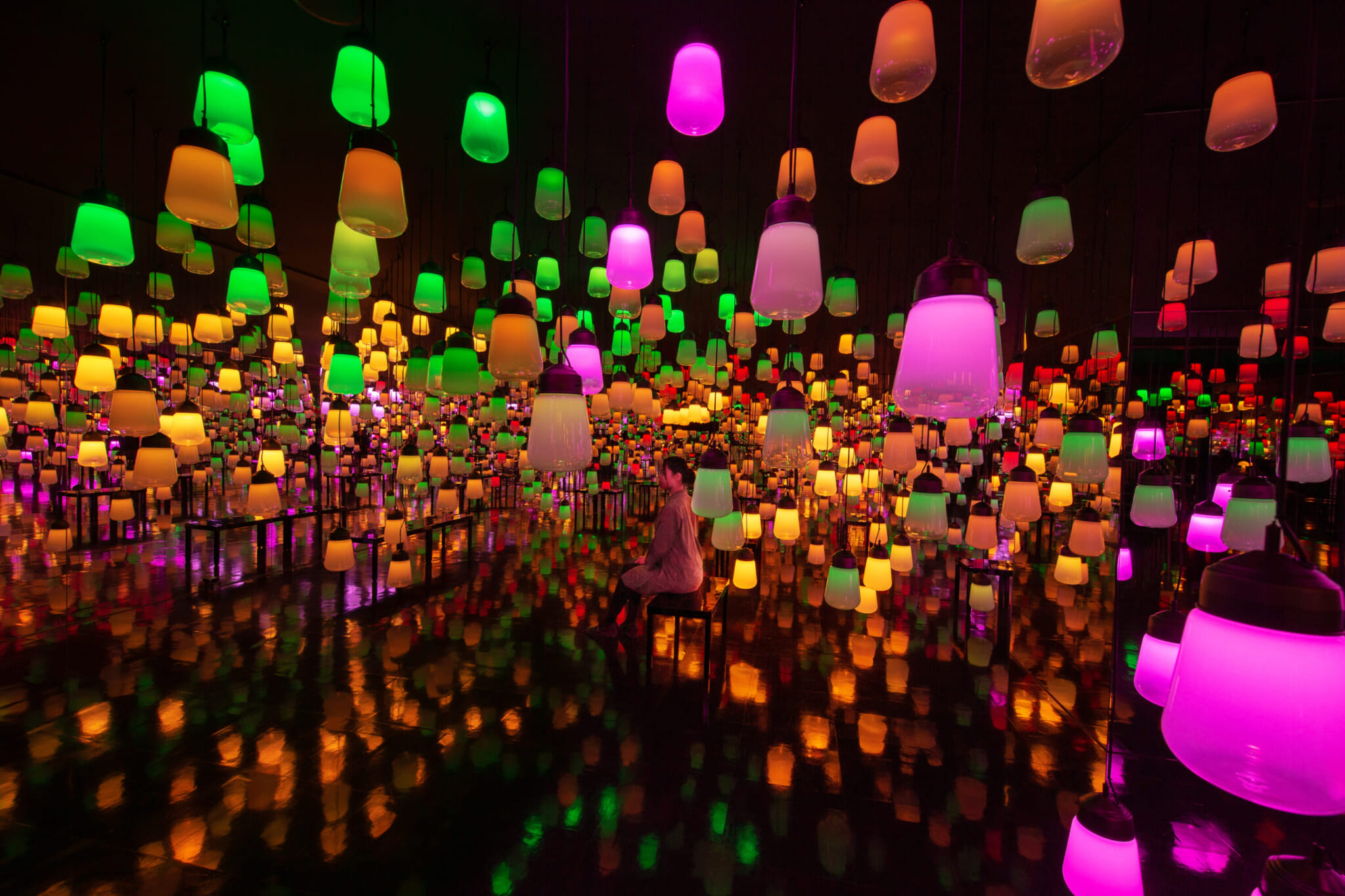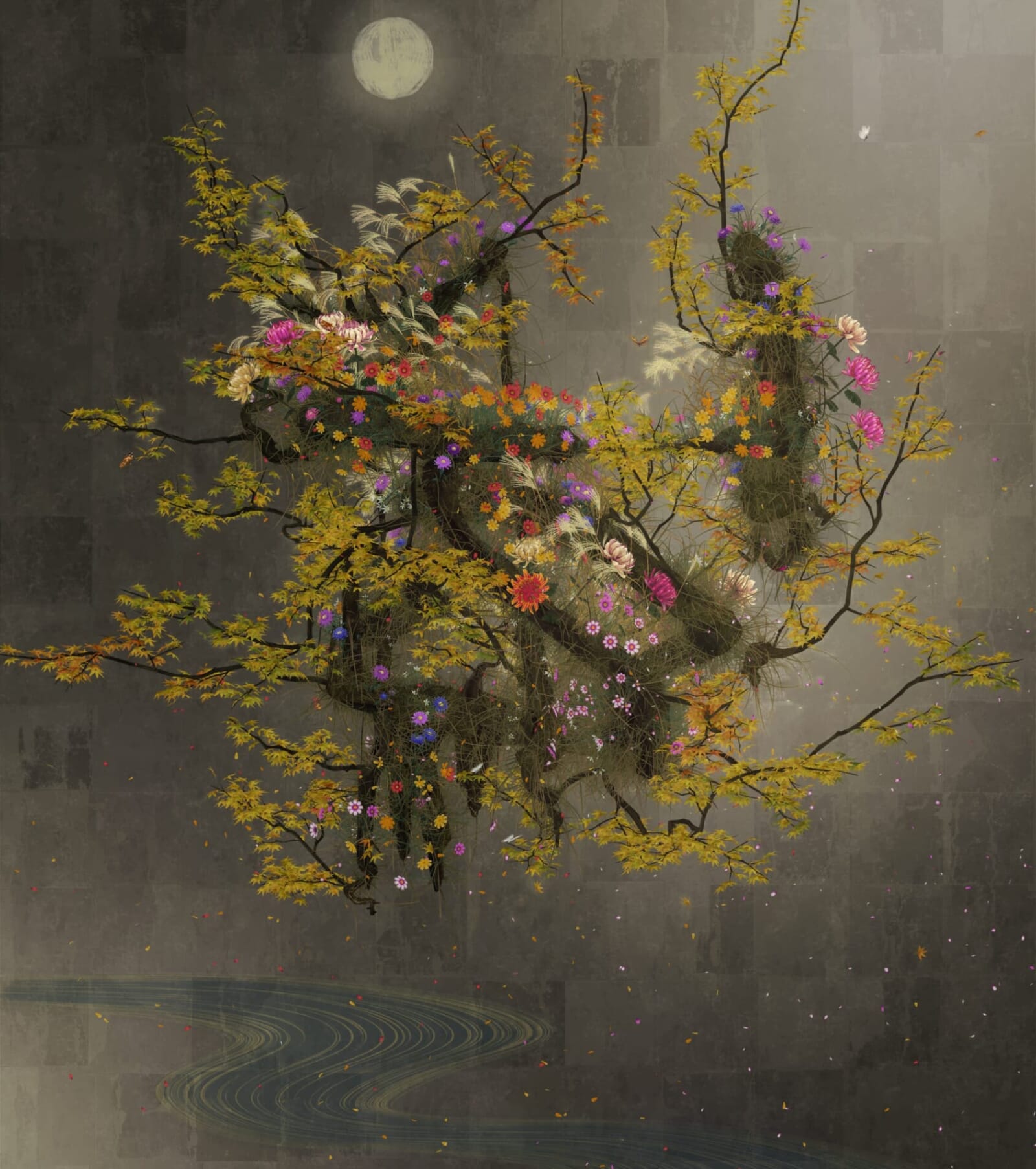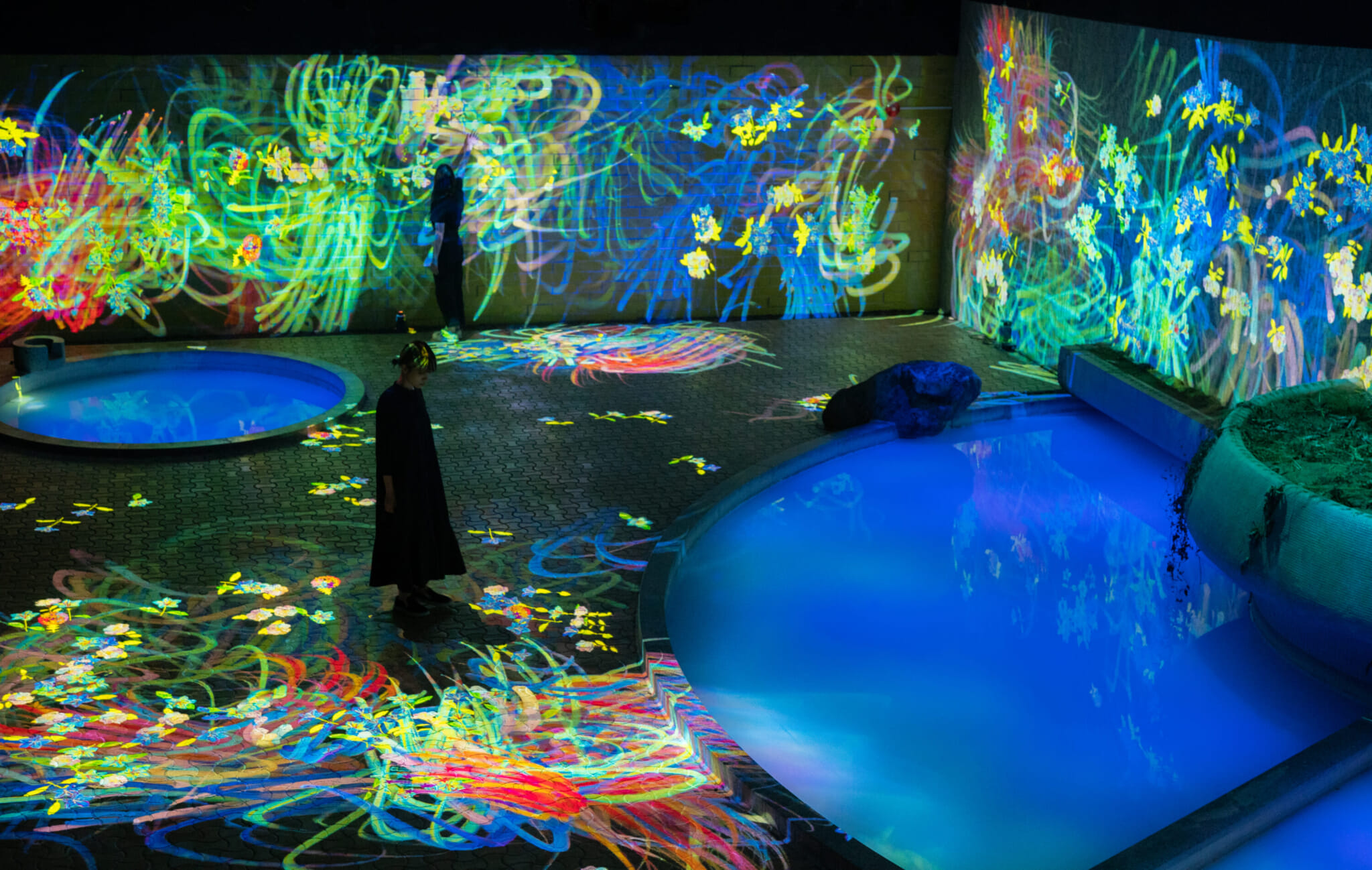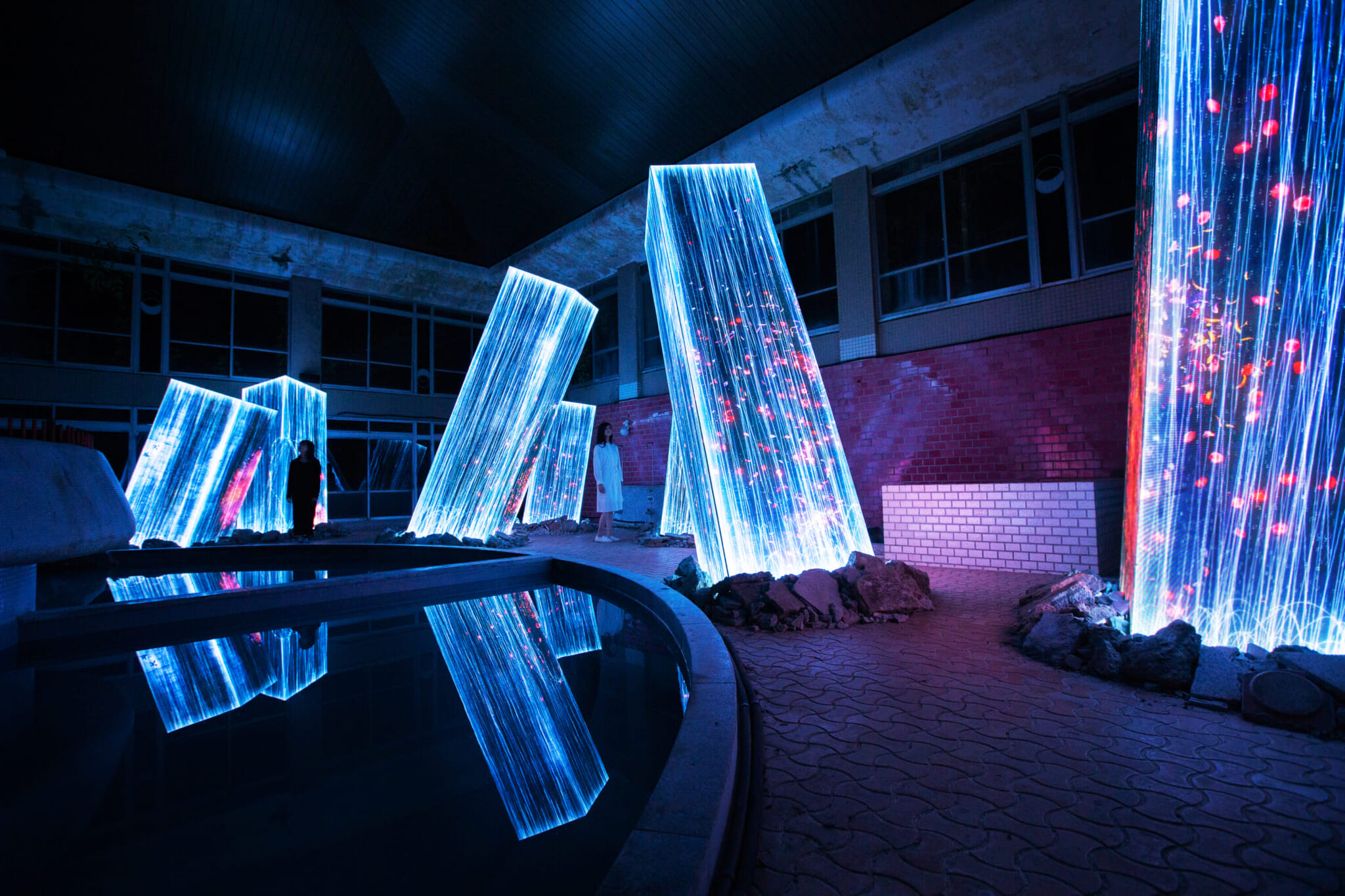If there is one key message that the Japan-based international art collective teamLab wants to convey, it’s that the world is borderless. They’re known for creating absorbing, interactive digital art installations that meld technology, nature and human interaction, calling into question the boundaries between artwork, environment and viewer: “Connecting in more complex ways, eternally changing and creating one borderless world,” reads the collective’s statement about their teamLab Borderless museum in Tokyo.
Their installations, which create impressive and immersive landscapes using light and sound, have found homes on several continents, as well as in other cities within Japan. Among these, one of the most arresting exhibitions is situated deep in the forests of Saga Prefecture, in and around the historic Mifuneyama Rakuen Hotel. Parts of the hotel have been transformed into interactive art spaces; there are also works on display in the neighboring Mifuneyama Rakuen Gardens. Some of these exhibits are permanent, while others take place seasonally from summer to fall.

“Forest and Spiral of Resonating Lamps – One Stroke.” teamLab Ruins and Heritage: Rinkan Spa & Tea Ceremony, Mifuneyama Rakuen, Takeo Hot Springs, Kyushu © teamLab
A Hotel Bursting with Interactive Art
Nestled alongside Mount Mifune, in a corner of the 500,000-square-meter Mifune Rakuen Gardens, the Mifuneyama Rakuen Hotel has been operating since 1966. With the help of teamLab, the hotel pays homage to the nature and culture of the surrounding area while also looking toward the future. In the lobby, visitors can find a permanent installation, titled “Forest and Spiral of Resonating Lamps — One Stroke.” It consists of a room filled with a profusion of colorful lamps, whose hues represent the fruitful nature of Mount Mifune. Their colors change throughout the year, in line with the four seasons as well as with flower blossoming times such as cherry blossoms in spring and hydrangeas in summer.
This installation is interactive: The lamps radiate more brightly when someone stands close by. The bright light then spreads to the two closest lamps, and so on in a chain reaction before returning to the starting position — hence the “one stroke” in the name.

“Life Survives by the Power of Life II.” teamLab Ruins and Heritage: Rinkan Spa & Tea Ceremony, Mifuneyama Rakuen, Takeo Hot Springs, Kyushu © teamLab
Freely open to hotel guests (either guests at Mifuneyama Rakuen Hotel or the nearby Onyado Chikurintei), this digital art lobby can also be visited by non-guests coming into the En Tea House Otoro. Head to the counter-only café space in a corner of the lobby floor to try tea from Saga’s Ureshino city, accompanied by Japanese sweets. You can take your tea and sip it anywhere in the lobby.
Hotel guests will also discover “Life Survives by the Power of Life II,” another artwork running in a 60-minute loop. In it, the kanji character for “life” is written using spatial calligraphy, a technique teamLab has been exploring since its founding that reconstructs calligraphy in a three-dimensional space.

“Flowers Bombing in the Bath House Ruins.” teamLab Ruins and Heritage: Rinkan Spa & Tea Ceremony, Mifuneyama Rakuen, Takeo Hot Springs, Kyushu © teamLab
Creativity Blooms in the Bath House Ruins
The ongoing collaboration between teamLab and Mifuneyama Rakuen Hotel extends beyond the hotel’s lobby and into a nearby abandoned bath house. In this exhibition, titled “teamLab Ruins and Heritage: Rinkan Sauna & Tea Ceremony,” guests can take in a variety of large-scale art pieces, including “Megaliths in the Bath House Ruins,” where, true to the name, large megalithic structures jut out of the dilapidated bath house floor. Computer-rendered images of flowers and flowing water are depicted each of these, constantly changing and evolving in response to the movements of those viewing. A years’ worth of flowers bloom and scatter in a single hour — they grow and bloom more abundantly if the onlooker remains still near the artwork.
In another piece, “Flowers Bombing in the Bath House Ruins,” flowers appear to bloom across the bath house walls in tune with visitors’ movements, and in “Universe of Fire Particles in a Decaying Underground Passage,” which is set in a long corridor leading from the main exhibition area, an eternal, computer-generated flame burns. If so inclined, guests can opt to get a combination ticket, which grants access to both the exhibit and Mifuneyama Rakuen Hotel’s sumptuous Rakan open-air bath and sauna.

Mifune Rakuen. teamLab Ruins and Heritage: Rinkan Spa & Tea Ceremony, Mifuneyama Rakuen, Takeo Hot Springs, Kyushu © teamLab
Centuries of Heritage in Mifuneyama Rakuen Garden
The Mifuneyama Rakuen Garden provides a scenic backdrop to the installations at Mifuneyama Rakuen Hotel, but the sprawling, pristine natural space is well worth a visit itself. Covered with hundreds of thousands of trees and flowers, it offers a lush view at any time of year: cherry blossoms in the spring, azaleas and wisteria in the summer, fiery foliage in the autumn and camellias and heavenly snowscapes come winter. The park is also famous for its sacred spots: the 3,000-year-old camphor tree Takeo no Okutsu, 500 statues depicting Buddha’s disciples and an iwakura stone containing a small shrine.
In the summer, the park is home to the annual exhibition “teamLab: A Forest Where Gods Live,” which usually runs from July to November. The 2024 iteration has already been confirmed. Last year’s iteration saw vibrant koi fish projected onto the surface of Mifuneyama Rakuen Pond, interacting with small rowboats; an illuminated valley of azalea flowers; a luminous, phantom waterfall; blossoming flowers projected on a massive boulder and more.
To book a stay at the Mifuneyama Rakuen Hotel, visit their website.
For more information about the teamLab exhibitions at and around the hotel, see the teamLab website.
This article appeared in Kyushu Weekender 2024. To read the whole issue, click here.









